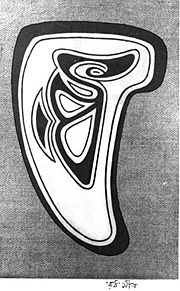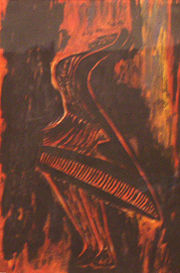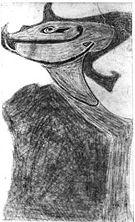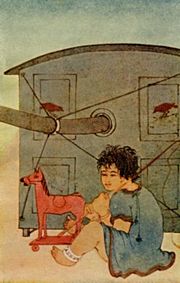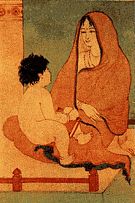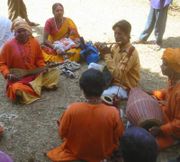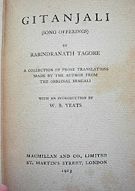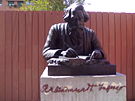Rabindranath Tagore
2008/9 Schools Wikipedia Selection. Related subjects: Writers and critics
| Rabindranath Tagore | |
|---|---|
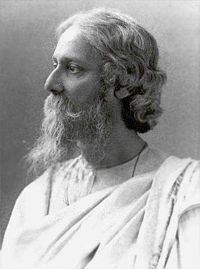 Rabindranath Tagore in Kolkata, c. 1915 |
|
| Born | 7 May 1861 Calcutta |
| Died | 7 August 1941 (aged 80) Calcutta |
| Occupation | poet, playwright, philosopher, composer, artist |
| Writing period | Bengal Renaissance |
| Notable award(s) | (1913) |
|
Influenced
|
|
| Signature | |
Rabindranath Tagore (Bengali: রবীন্দ্রনাথ ঠাকুর, IPA: [ɾobin̪d̪ɾonat̪ʰ ʈʰakuɾ] ) ( 7 May 1861– 7 August 1941), also known by the sobriquet Gurudev, was a Bengali poet, Brahmo religionist, visual artist, playwright, novelist, and composer whose works reshaped Bengali literature and music in the late 19th and early 20th centuries. He became Asia's first Nobel laureate when he won the 1913 Nobel Prize in Literature.
A Pirali Brahmin (a ".. supposed stigma", ".. formed a party for degrading them", ".. orthodox kind relying on hearsay for their facts") from Calcutta, Bengal, Tagore first wrote poems at the age of eight. At the age of sixteen, he published his first substantial poetry under the pseudonym Bhanushingho ("Sun Lion") and wrote his first short stories and dramas in 1877. In later life Tagore protested strongly against the British Raj and gave his support to the Indian Independence Movement. Tagore's life work endures, in the form of his poetry and the institution he founded, Visva-Bharati University.
Tagore wrote novels, short stories, songs, dance-dramas, and essays on political and personal topics. Gitanjali (Song Offerings), Gora (Fair-Faced), and Ghare-Baire (The Home and the World) are among his best-known works. His verse, short stories, and novels, which often exhibited rhythmic lyricism, colloquial language, meditative naturalism, and philosophical contemplation, received worldwide acclaim. Tagore was also a cultural reformer and polymath who modernised Bengali art by rejecting strictures binding it to classical Indian forms. Two songs from his canon are now the national anthems of Bangladesh and India: the Amar Shonar Bangla and the Jana Gana Mana respectively.
Early life (1861–1901)
Tagore (nicknamed "Rabi") was born the youngest of thirteen surviving children in the Jorasanko mansion in Calcutta (now Kolkata, India) of parents Debendranath Tagore and Sarada Devi. The Tagore family were the Brahmo founding fathers of the Adi Dharm faith. After undergoing his upanayan at age eleven, Tagore and his father left Calcutta on 14 February 1873 to tour India for several months, visiting his father's Santiniketan estate and Amritsar before reaching the Himalayan hill station of Dalhousie. There, Tagore read biographies, studied history, astronomy, modern science, and Sanskrit, and examined the classical poetry of Kālidāsa. In 1877, he rose to notability when he composed several works, including a long poem set in the Maithili style pioneered by Vidyapati. As a joke, he maintained that these were the lost works of Bhānusiṃha, a newly discovered 17th-century Vaiṣṇava poet. He also wrote "Bhikharini" (1877; "The Beggar Woman"—the Bengali language's first short story) and Sandhya Sangit (1882) —including the famous poem "Nirjharer Swapnabhanga" ("The Rousing of the Waterfall").
Seeking to become a barrister, Tagore enrolled at a public school in Brighton, England in 1878. He studied law at University College London, but returned to Bengal in 1880 without a degree. On 9 December 1883 he married Mrinalini Devi (born Bhabatarini, 1873–1900); they had five children, two of whom later died before reaching adulthood. In 1890, Tagore began managing his family's estates in Shilaidaha, a region now in Bangladesh; he was joined by his wife and children in 1898. Known as " Zamindar Babu", Tagore traveled across the vast estate while living out of the family's luxurious barge, the Padma, to collect (mostly token) rents and bless villagers; in return, appreciative villagers held feasts in his honour. These years, which composed Tagore's Sadhana period (1891–1895; named for one of Tagore’s magazines), were among his most fecund. During this period, more than half the stories of the three-volume and eighty-four-story Galpaguchchha were written. With irony and emotional weight, they depicted a wide range of Bengali lifestyles, particularly village life.
Shantiniketan (1901–1932)
In 1901, Tagore left Shilaidaha and moved to Santiniketan ( West Bengal) to found an ashram, which would grow to include a marble-floored prayer hall ("The Mandir"), an experimental school, groves of trees, gardens, and a library. There, Tagore's wife and two of his children died. His father died on 19 January 1905, and he began receiving monthly payments as part of his inheritance. He received additional income from the Maharaja of Tripura, sales of his family's jewellery, his seaside bungalow in Puri, and mediocre royalties (Rs. 2,000) from his works. By now, his work was gaining him a large following among Bengali and foreign readers alike, and he published such works as Naivedya (1901) and Kheya (1906) while translating his poems into free verse. On 14 November 1913, Tagore learned that he had won the 1913 Nobel Prize in Literature. According to the Swedish Academy, it was given due to the idealistic and—for Western readers—accessible nature of a small body of his translated material, including the 1912 Gitanjali: Song Offerings. In 1915, Tagore received the knighthood from the British Crown. But as a mark of rebuke to the rulers, post the Jallianwala Bagh massacre in 1919, he renounced the title.
In 1921, Tagore and agricultural economist Leonard Elmhirst set up the Institute for Rural Reconstruction (which Tagore later renamed Shriniketan—"Abode of Wealth") in Surul, a village near the ashram at Santiniketan. Through it, Tagore sought to provide an alternative to Gandhi's symbol- and protest-based Swaraj movement, which he denounced. He recruited scholars, donors, and officials from many countries to help the Institute use schooling to "free village[s] from the shackles of helplessness and ignorance" by "vitaliz[ing] knowledge". In the early 1930s, he also grew more concerned about India's "abnormal caste consciousness" and untouchability, lecturing on its evils, writing poems and dramas with untouchable protagonists, and appealing to authorities at the Guruvayoor Temple to admit Dalits.
Twilight years (1932–1941)
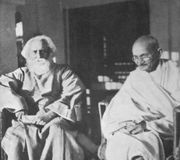
In his last decade, Tagore remained in the public limelight, publicly upbraiding Gandhi for stating that a massive 15 January 1934 earthquake in Bihar constituted divine retribution for the subjugation of Dalits. He also mourned the incipient socioeconomic decline of Bengal and the endemic poverty of Calcutta; he detailed the latter in an unrhymed hundred-line poem whose technique of searing double-vision would foreshadow Satyajit Ray's film Apur Sansar. Tagore also compiled fifteen volumes of writings, including the prose-poems works Punashcha (1932), Shes Saptak (1935), and Patraput (1936). He continued his experimentations by developing prose-songs and dance-dramas, including Chitrangada (1914), Shyama (1939), and Chandalika (1938), and wrote the novels Dui Bon (1933), Malancha (1934), and Char Adhyay (1934). Tagore took an interest in science in his last years, writing Visva-Parichay (a collection of essays) in 1937. His exploration of biology, physics, and astronomy impacted his poetry, which often contained extensive naturalism that underscored his respect for scientific laws. He also wove the process of science (including narratives of scientists) into many stories contained in such volumes as Se (1937), Tin Sangi (1940), and Galpasalpa (1941).
Tagore's last four years were marked by chronic pain and two long periods of illness. These began when Tagore lost consciousness in late 1937; he remained comatose and near death for an extended period. This was followed three years later in late 1940 by a similar spell, from which he never recovered. The poetry Tagore wrote in these years is among his finest, and is distinctive for its preoccupation with death. After extended suffering, Tagore died on 7 August 1941 (22 Shravan 1348) in an upstairs room of the Jorasanko mansion in which he was raised; his death anniversary is still mourned in public functions held across the Bengali-speaking world.
Travels
Owing to his notable wanderlust, between 1878 and 1932, Tagore visited more than thirty countries on five continents; many of these trips were crucial in familiarising non-Indian audiences to his works and spreading his political ideas. In 1912, he took a sheaf of his translated works to England, where they impressed missionary and Gandhi protégé Charles F. Andrews, Anglo-Irish poet William Butler Yeats, Ezra Pound, Robert Bridges, Ernest Rhys, Thomas Sturge Moore, and others. Indeed, Yeats wrote the preface to the English translation of Gitanjali, while Andrews joined Tagore at Santiniketan. On 10 November 1912, Tagore toured the United States and the United Kingdom, staying in Butterton, Staffordshire with Andrews’ clergymen friends. From 3 May 1916 until April 1917, Tagore went on lecturing circuits in Japan and the United States, during which he denounced nationalism—particularly that of the Japanese and Americans. He also wrote the essay "Nationalism in India", attracting both derision and praise (the latter from pacifists, including Romain Rolland).
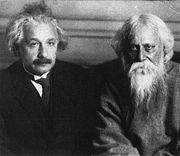
Shortly after returning to India, the 63-year-old Tagore visited Peru at the invitation of the Peruvian government, and took the opportunity to visit Mexico as well. Both governments pledged donations of $100,000 to the school at Shantiniketan (Visva-Bharati) in commemoration of his visits. A week after his November 6, 1924 arrival in Buenos Aires, Argentina, an ill Tagore moved into the Villa Miralrío at the behest of Victoria Ocampo. He left for India in January 1925. On 30 May 1926, Tagore reached Naples, Italy; he met fascist dictator Benito Mussolini in Rome the next day. Their initially warm rapport lasted until Tagore spoke out against Mussolini on 20 July 1926.
On 14 July 1927, Tagore and two companions began a four-month tour of Southeast Asia, visiting Bali, Java, Kuala Lumpur, Malacca, Penang, Siam, and Singapore. Tagore's travelogues from the tour were collected into the work "Jatri". In early 1930 he left Bengal for a nearly year-long tour of Europe and the United States. Once he returned to the UK, while his paintings were being exhibited in Paris and London, he stayed at a Friends settlement in Birmingham. There, he wrote his Hibbert Lectures for the University of Oxford (which dealt with the "idea of the humanity of our God, or the divinity of Man the Eternal") and spoke at London's annual Quaker gathering. There (addressing relations between the British and Indians, a topic he would grapple with over the next two years), Tagore spoke of a "dark chasm of aloofness". He later visited Aga Khan III, stayed at Dartington Hall, then toured Denmark, Switzerland, and Germany from June to mid-September 1930, then the Soviet Union. Lastly, in April 1932, Tagore—who was acquainted with the legends and works of the Persian mystic Hafez—was invited as a personal guest of Shah Reza Shah Pahlavi of Iran. Such extensive travels allowed Tagore to interact with many notable contemporaries, including Henri Bergson, Albert Einstein, Robert Frost, Thomas Mann, George Bernard Shaw, H.G. Wells and Romain Rolland. Tagore's last travels abroad, including visits to Persia and Iraq (in 1932) and Ceylon in 1933, only sharpened his opinions regarding human divisions and nationalism.
Works
Tagore's literary reputation is disproportionately influenced by regard for his poetry; however, he also wrote novels, essays, short stories, travelogues, dramas, and thousands of songs. Of Tagore's prose, his short stories are perhaps most highly regarded; indeed, he is credited with originating the Bengali-language version of the genre. His works are frequently noted for their rhythmic, optimistic, and lyrical nature. Such stories mostly borrow from deceptively simple subject matter: the lives of ordinary people.
Novels and non-fiction
Tagore wrote eight novels and four novellas, including Chaturanga, Shesher Kobita, Char Odhay, and Noukadubi. Ghare Baire ( The Home and the World)—through the lens of the idealistic zamindar protagonist Nikhil—excoriates rising Indian nationalism, terrorism, and religious zeal in the Swadeshi movement; a frank expression of Tagore's conflicted sentiments, it emerged out of a 1914 bout of depression. Indeed, the novel bleakly ends with Hindu-Muslim sectarian violence and Nikhil's being (probably mortally) wounded. In some sense, Gora shares the same theme, raising controversial questions regarding the Indian identity. As with Ghore Baire, matters of self-identity ( jāti), personal freedom, and religion are developed in the context of a family story and love triangle. Another powerful story is Jogajog (Relationships), where the heroine Kumudini—bound by the ideals of Shiva- Sati, exemplified by Dākshāyani—is torn between her pity for the sinking fortunes of her progressive and compassionate elder brother and his foil: her exploitative, rakish, and patriarchical husband. In it, Tagore demonstrates his feminist leanings, using pathos to depict the plight and ultimate demise of Bengali women trapped by pregnancy, duty, and family honour; simultaneously, he treats the decline of Bengal's landed oligarchy.
Other novels were more uplifting: Shesher Kobita (translated twice—Last Poem and Farewell Song) is his most lyrical novel, with poems and rhythmic passages written by the main character (a poet). It also contains elements of satire and postmodernism; stock characters gleefully attack the reputation of an old, outmoded, oppressively renowned poet who, incidentally, goes by the name of Rabindranath Tagore. Though his novels remain among the least-appreciated of his works, they have been given renewed attention via film adaptations by such directors as Satyajit Ray; these include Chokher Bali and Ghare Baire; many have soundtracks featuring selections from Tagore's own [[Rabindra sangeet. Tagore wrote many non-fiction books, writing on topics ranging from Indian history to linguistics. Aside from autobiographical works, his travelogues, essays, and lectures were compiled into several volumes, including Iurop Jatrir Patro (Letters from Europe) and Manusher Dhormo (The Religion of Man).
Music and artwork
Tagore was a prolific musician and painter, writing around 2,230 songs. They comprise rabindrasangit (Bengali: রবীন্দ্র সংগীত—"Tagore Song"), now an integral part of Bengali culture. Tagore's music is inseparable from his literature, most of which—poems or parts of novels, stories, or plays alike—became lyrics for his songs. Primarily influenced by the thumri style of Hindustani classical music, they ran the entire gamut of human emotion, ranging from his early dirge-like Brahmo devotional hymns to quasi-erotic compositions. They emulated the tonal colour of classical ragas to varying extents. Though at times his songs mimicked a given raga's melody and rhythm faithfully, he also blended elements of different ragas to create innovative works.
For Bengalis, their appeal, stemming from the combination of emotive strength and beauty described as surpassing even Tagore's poetry, was such that the Modern Review observed that "[t]here is in Bengal no cultured home where Rabindranath's songs are not sung or at least attempted to be sung ... Even illiterate villagers sing his songs". Music critic Arthur Strangways of The Observer first introduced non-Bengalis to rabindrasangeet with his book The Music of Hindostan, which described it as a "vehicle of a personality ... [that] go behind this or that system of music to that beauty of sound which all systems put out their hands to seize." Among them are Bangladesh's national anthem Amar Shonar Bangla (Bengali: আমার সোনার বাঙলা) and India's national anthem Jana Gana Mana (Bengali: জন গণ মন); Tagore thus became the only person ever to have written the national anthems of two nations. In turn, rabindrasangeet influenced the styles of such musicians as sitar maestro Vilayat Khan, and the sarodiyas Buddhadev Dasgupta and Amjad Ali Khan.
At age sixty, Tagore took up drawing and painting; successful exhibitions of his many works—which made a debut appearance in Paris upon encouragement by artists he met in the south of France—were held throughout Europe. Tagore—who likely exhibited protanopia ("colour blindness"), or partial lack of (red-green, in Tagore's case) colour discernment—painted in a style characterised by peculiarities in aesthetics and colouring schemes. Nevertheless, Tagore took to emulating numerous styles, including that of craftwork by the Malanggan people of northern New Ireland, Haida carvings from the west coast of Canada (British Columbia), and woodcuts by Max Pechstein. Tagore also had an artist's eye for his own handwriting, embellishing the scribbles, cross-outs, and word layouts in his manuscripts with simple artistic leitmotifs, including simple rhythmic designs.
Theatrical pieces
Tagore's experience in theatre began at age sixteen, when he played the lead role in his brother Jyotirindranath's adaptation of Molière's Le Bourgeois Gentilhomme. At age twenty, he wrote his first drama-opera—Valmiki Pratibha (The Genius of Valmiki)—which describes how the bandit Valmiki reforms his ethos, is blessed by Saraswati, and composes the Rāmāyana. Through it, Tagore vigorously explores a wide range of dramatic styles and emotions, including usage of revamped kirtans and adaptation of traditional English and Irish folk melodies as drinking songs. Another notable play, Dak Ghar (The Post Office), describes how a child—striving to escape his stuffy confines—ultimately "fall[s] asleep" (which suggests his physical death). A story with worldwide appeal (it received rave reviews in Europe), Dak Ghar dealt with death as, in Tagore's words, "spiritual freedom" from "the world of hoarded wealth and certified creeds".
His other works—emphasizing fusion of lyrical flow and emotional rhythm tightly focused on a core idea—were unlike previous Bengali dramas. His works sought to articulate, in Tagore's words, "the play of feeling and not of action". In 1890 he wrote Visarjan (Sacrifice), regarded as his finest drama. The Bengali-language originals included intricate subplots and extended monologues. Later, his dramas probed more philosophical and allegorical themes; these included Dak Ghar. Another is Tagore's Chandalika (Untouchable Girl), which was modeled on an ancient Buddhist legend describing how Ananda—the Gautama Buddha's disciple—asks water of an Adivasi ("untouchable") girl. Lastly, among his most famous dramas is Raktakaravi (Red Oleanders), which tells of a kleptocratic king who enriches himself by forcing his subjects to mine. The heroine, Nandini, eventually rallies the common people to destroy these symbols of subjugation. Tagore's other plays include Chitrangada, Raja, and Mayar Khela. Dance dramas based on Tagore's plays are commonly referred to as rabindra nritya natyas.
Short stories
Tagore’s "Sadhana" period, comprising the four years from 1891 to 1895, was named for one of Tagore’s magazines. This period was among Tagore 's most fecund, yielding more than half the stories contained in the three-volume Galpaguchchha, which itself is a collection of eighty-four stories. Such stories usually showcase Tagore’s reflections upon his surroundings, on modern and fashionable ideas, and on interesting mind puzzles (which Tagore was fond of testing his intellect with). Tagore typically associated his earliest stories (such as those of the "Sadhana" period) with an exuberance of vitality and spontaneity; these characteristics were intimately connected with Tagore’s life in the common villages of, among others, Patisar, Shajadpur, and Shilaida while managing the Tagore family’s vast landholdings. There, he beheld the lives of India’s poor and common people; Tagore thereby took to examining their lives with a penetrative depth and feeling that was singular in Indian literature up to that point.
In "The Fruitseller from Kabul", Tagore speaks in first person as town-dweller and novelist who chances upon the Afghani seller. He attempts to distil the sense of longing felt by those long trapped in the mundane and hardscrabble confines of Indian urban life, giving play to dreams of a different existence in the distant and wild mountains: "There were autumn mornings, the time of year when kings of old went forth to conquest; and I, never stirring from my little corner in Calcutta, would let my mind wander over the whole world. At the very name of another country, my heart would go out to it ... I would fall to weaving a network of dreams: the mountains, the glens, the forest .... ". Many of the other Galpaguchchha stories were written in Tagore’s Sabuj Patra period (1914–1917; also named for one of Tagore's magazines).
Tagore's Golpoguchchho (Bunch of Stories) remains among Bengali literature's most popular fictional works, providing subject matter for many successful films and theatrical plays. Satyajit Ray's film Charulata was based upon Tagore's controversial novella, Nastanirh (The Broken Nest). In Atithi (also made into a film), the young Brahmin boy Tarapada shares a boat ride with a village zamindar. The boy reveals that he has run away from home, only to wander around ever since. Taking pity, the zamindar adopts him and ultimately arranges his marriage to the zamindar's own daughter. However, the night before the wedding, Tarapada runs off—again. Strir Patra (The Letter from the Wife) is among Bengali literature's earliest depictions of the bold emancipation of women. The heroine Mrinal, the wife of a typical patriarchical Bengali middle class man, writes a letter while she is traveling (which constitutes the whole story). It details the pettiness of her life and struggles; she finally declares that she will not return to her husband's home with the statement Amio bachbo. Ei bachlum ("And I shall live. Here, I live").
In Haimanti, Tagore takes on the institution of Hindu marriage, describing the dismal lifelessness of married Bengali women, hypocrisies plaguing the Indian middle classes, and how Haimanti, a sensitive young woman, must—due to her sensitiveness and free spirit—sacrifice her life. In the last passage, Tagore directly attacks the Hindu custom of glorifying Sita's attempted self-immolation as a means of appeasing her husband Rama's doubts. Tagore also examines Hindu-Muslim tensions in Musalmani Didi, which in many ways embodies the essence of Tagore's humanism. On the other hand, Darpaharan exhibits Tagore's self-consciousness, describing a young man harboring literary ambitions. Though he loves his wife, he wishes to stifle her own literary career, deeming it unfeminine. Tagore himself, in his youth, seems to have harbored similar ideas about women. Darpaharan depicts the final humbling of the man via his acceptance of his wife's talents. As many other Tagore stories, Jibito o Mrito provides the Bengalis with one of their more widely used epigrams: Kadombini moriya proman korilo she more nai ("Kadombini died, thereby proved that she hadn't").
Poetry
Tagore's poetry—which varied in style from classical formalism to the comic, visionary, and ecstatic—proceeds out a lineage established by 15th- and 16th-century Vaiṣṇava poets. Tagore was also influenced by the mysticism of the rishi-authors who—including Vyasa—wrote the Upanishads, the Bhakta- Sufi mystic Kabir, and Ramprasad. Yet Tagore's poetry became most innovative and mature after his exposure to rural Bengal's folk music, which included ballads sung by Bāul folk singers—especially the bard Lālan Śāh. These—which were rediscovered and popularised by Tagore—resemble 19th-century Kartābhajā hymns that emphasize inward divinity and rebellion against religious and social orthodoxy. During his Shilaidaha years, his poems took on a lyrical quality, speaking via the maner manus (the Bāuls' "man within the heart") or meditating upon the jivan devata ("living God within"). This figure thus sought connection with divinity through appeal to nature and the emotional interplay of human drama. Tagore used such techniques in his Bhānusiṃha poems (which chronicle the romance between Radha and Krishna), which he repeatedly revised over the course of seventy years.
Later, Tagore responded to the (mostly) crude emergence of modernism and realism in Bengali literature by writing experimental works in the 1930s. Examples works include Africa and Camalia, which are among the better known of his latter poems. He also occasionally wrote poems using Shadhu Bhasha (a Sanskritised dialect of Bengali); later, he began using Cholti Bhasha (a more popular dialect). Other notable works include Manasi, Sonar Tori (Golden Boat), Balaka (Wild Geese—the title being a metaphor for migrating souls), and Purobi. Sonar Tori's most famous poem—dealing with the ephemeral nature of life and achievement—goes by the same name; it ends with the haunting phrase "শূন্য নদীর তীরে রহিনু পড়ি / যাহা ছিল লয়ে গেল সোনার তরী" ("Shunno nodir tire rohinu poŗi / Jaha chhilo loe gêlo shonar tori"—"all I had achieved was carried off on the golden boat—only I was left behind."). Internationally, Gitanjali (Bengali: গীতাঞ্জলি) is Tagore's best-known collection, winning him his Nobel Prize. Song VII (গীতাঞ্জলি 127) of Gitanjali:
|
|
Free-verse translation by Tagore (Gitanjali, verse VII):
|
|
"Klanti" (Bengali: ক্লান্তি; "Fatigue"), the sixth poem in Gitali, reads:
|
|
Tagore's poetry has been set to music by various composers, among them classical composer Arthur Shepherd's triptych for soprano and string quartet, as well as composer Garry Schyman's "Praan," an adaptation of Tagore's poem "Stream of Life" from Gitanjali. The latter was composed and recorded with vocals by Palbasha Siddique to accompany Internet celebrity Matt Harding's 2008 viral video .
Political views
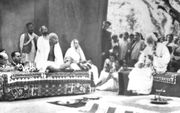
Marked complexities characterise Tagore's political views. He criticised European imperialism and supported Indian nationalists and, although he himself vehemently denied it at the time, the evidence produced during the Hindu-German Conspiracy trial, as well as some later accounts, he was aware of the conspiracy and even interviewed the then Japanese premier Count Terauchi and former premier Count Okuma on behalf of the conspirators to try and enlist Japanese support. However, he also lampooned the Swadeshi movement, denouncing it in "The Cult of the Charka", an acrid 1925 essay. Instead, he emphasized self-help and intellectual uplift of the masses, stating that British imperialism was not a primary evil, but instead a "political symptom of our social disease", urging Indians to accept that "there can be no question of blind revolution, but of steady and purposeful education".
Such views inevitably enraged many, placing his life in danger: during his stay in a San Francisco hotel in late 1916, Tagore narrowly escaped assassination by Indian expatriates. The plot failed only because the would-be assassins fell into argument. Yet Tagore wrote songs lionizing the Indian independence movement and renounced his knighthood in protest against the 1919 Jallianwala Bagh Massacre. Two of Tagore's more politically charged compositions, " Chitto Jetha Bhayshunyo" ("Where the Mind is Without Fear") and " Ekla Chalo Re" ("If They Answer Not to Thy Call, Walk Alone"), gained mass appeal, with the latter favoured by Gandhi. Despite his tumultuous relations with Gandhi, Tagore was key in resolving a Gandhi- Ambedkar dispute involving separate electorates for untouchables, ending Gandhi's fast "unto death".
Tagore also criticised orthodox (rote-oriented) education, lampooning it in the short story "The Parrot's Training", where a bird—which ultimately dies—is caged by tutors and force-fed pages torn from books. These views led Tagore—while visiting Santa Barbara, California on 11 October 1917—to conceive of a new type of university, desiring to "make [his ashram at] Santiniketan the connecting thread between India and the world ... [and] a world centre for the study of humanity ... somewhere beyond the limits of nation and geography." The school—which he named Visva-Bharati—had its foundation stone laid on 22 December 1918; it was later inaugurated on 22 December 1921. Here, Tagore implemented a brahmacharya pedagogical structure employing gurus to provide individualised guidance for pupils. Tagore worked hard to fundraise for and staff the school, even contributing all of his Nobel Prize monies. Tagore’s duties as steward and mentor at Santiniketan kept him busy; he taught classes in mornings and wrote the students' textbooks in afternoons and evenings. Tagore also fundraised extensively for the school in Europe and the U.S. between 1919 and 1921.
Impact and legacy

Tagore's post-death impact can be felt through the many festivals held worldwide in his honour—examples include the annual Bengali festival/celebration of Kabipranam (Tagore's birthday anniversary), the annual Tagore Festival held in Urbana, Illinois in the United States, the Rabindra Path Parikrama walking pilgrimages leading from Calcutta to Shantiniketan, and ceremonial recitals of Tagore's poetry held on important anniversaries. This legacy is most palpable in Bengali culture, ranging from language and arts to history and politics; indeed, Nobel laureate Amartya Sen noted that even for modern Bengalis, Tagore was a "towering figure", being a "deeply relevant and many-sided contemporary thinker". Tagore's collected Bengali-language writings—the 1939 Rabīndra Racanāvalī—is also canonized as one of Bengal's greatest cultural treasures, while Tagore himself has been proclaimed "the greatest poet India has produced".
Tagore was famed throughout much of Europe, North America, and East Asia. He was key in founding Dartington Hall School, a progressive coeducational institution; in Japan, he influenced such figures as Nobel laureate Yasunari Kawabata. Tagore's works were widely translated into English, Dutch, German, Spanish, and other European languages by Czech indologist Vincenc Lesný, French Nobel laureate André Gide, Russian poet Anna Akhmatova, former Turkish Prime Minister Bülent Ecevit and others. In the United States, Tagore's popular lecturing circuits (especially those between 1916–1917) were widely attended and acclaimed. Nevertheless, several controversies involving Tagore resulted in a decline in his popularity in Japan and North America after the late 1920s, contributing to his "near total eclipse" outside of Bengal.
Tagore, through Spanish translations of his works, also influenced leading figures of Spanish literature, including Chileans Pablo Neruda and Gabriela Mistral, Mexican writer Octavio Paz, and Spaniards José Ortega y Gasset, Zenobia Camprubí, and Juan Ramón Jiménez. Between 1914 and 1922, the Jiménez-Camprubí spouses translated no less than twenty-two of Tagore's books from English into Spanish. Jiménez, as part of this work, also extensively revised and adapted such works as Tagore's The Crescent Moon. Indeed, during this time, Jiménez developed the now-heralded innovation of "naked poetry" (Spanish: «poesia desnuda»). Ortega y Gasset wrote that "Tagore's wide appeal [may stem from the fact that] he speaks of longings for perfection that we all have ... Tagore awakens a dormant sense of childish wonder, and he saturates the air with all kinds of enchanting promises for the reader, who ... pays little attention to the deeper import of Oriental mysticism". Tagore's works were published in free editions around 1920 alongside works by Dante Alighieri, Miguel de Cervantes, Johann Wolfgang von Goethe, Plato, and Leo Tolstoy.
Tagore's talents came to be regarded as overrated by several westerners. Graham Greene doubted that "anyone but Mr. Yeats can still take his poems very seriously." Modern remnants of a once widespread Latin American reverence of Tagore were discovered, for example, by an astonished Salman Rushdie during a trip to Nicaragua.
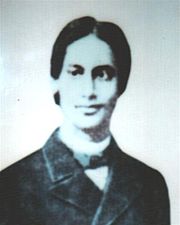
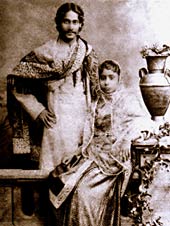
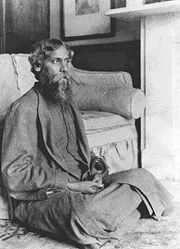
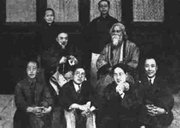
![Tagore (first row, third figure from right) meets members of the Iranian Majlis (Tehran, April-May 1932). Tagore visited Shiraz in the same year, [1].](../../images/869/86947.jpg)
